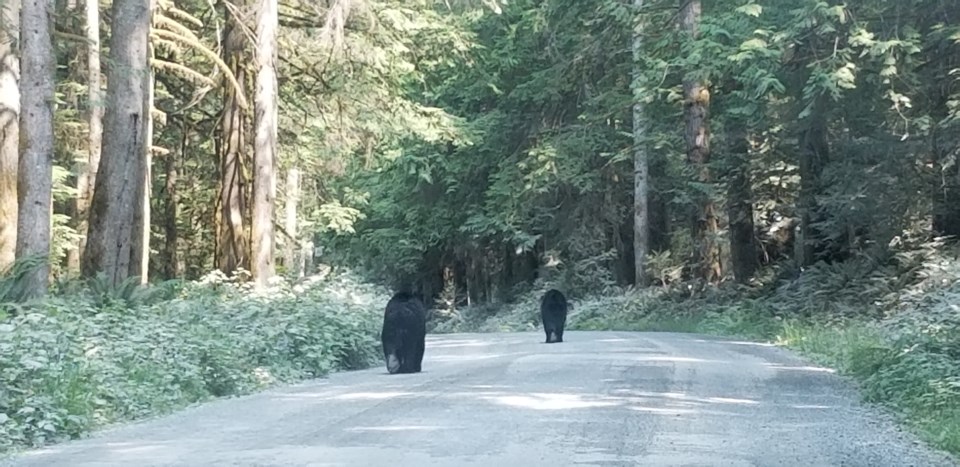According to WildSafeBC, most of BC is considered bear country with bears living in a wide variety of ecosystems.
“Black bears are omnivorous animals with vegetation making up about 80 per cent of their diet. They are renowned for their acute sense of smell that allows them to locate food at great distances. Bears are most active from April to November. While most bear encounters result in the bear leaving an area, they can become more assertive or destructive when they have learned to associate humans and their activities with food.”
Black bear smarts
Anecdotally, last year was an active black bear season in the qathet region, with some negative human/bear encounters reported in Wildwood, including someone being chased. With an increase in human and bear population on the Northern Sunshine Coast, fruit attractants, garbage and compost left outside that encourages bears to become conditioned to our food, it's not surprising.
Expert and artist
Wildwood resident Evelyn Kirkaldy is a bear expert and professional artist who has been educating the public and municipalities about being bear smart for many years. She is a former WildSafeBC coordinator for qathet Regional District, former coordinator of the Slocan Valley Bear Smart Program, and current advisor with bearsmart.com. She also is a painter and illustrator of bears and natural landscapes.
"I had my first [black bear] sighting today [March 22], seems to be early," said Kirkaldy. "Every year is different."
Kirkaldy emphasized that people can take simple steps to avoid bears coming around. Although qathet is considered bear country, garbage and compost bins are not necessarily bear resistant.
Keep smells inside
"The basics are to keep garbage securely stored until collection day," said Kirkaldy. "The best thing people can do with garbage is separate it, so it's not smelly."
For example, styrofoam trays that meat is packaged in can be washed and put in a freezer, or, avoid buying meat packed like that entirely if you can, added Kirkaldy.
Bears have an acute sense of smell and can detect food more than one kilometre away.
"Many items can be washed out and recycled," said Kirkaldy. "Wash those bins out, it's smelly in there."
Bring in birdfeeders
Another attractant is bird feeders.
"The only time the bird feeders are really needed is in the late winter when there's no food left anywhere," said Kirkaldy. "Feed pets indoors and clean your barbecue, cover it and keep it out of the wind."
Managing compost properly is another way to avoid a bear encounter, meaning freezing any smelly items, and only putting them outside in the bin on pickup day.
Garbage problem
"Garbage is reported in 60 per cent of the calls to conservation officers," stated WildSafeBC on its website.
Kirkaldy said electric fencing is recommended, but it needs to be installed properly.
"You can even use temporary electric fencing around fruit trees," she added.
Pick fruit/ electric fencing
Picking fruit when it ripens is ideal, too, but it can get out of hand for some people who can't keep up with the amount of production. Fruit trees are a consistent and predictable source of high calorie foods for bears, according to WildSafeBC: “A well-managed fruit tree is pruned to have a healthy and manageable harvest. Pick fruit early and allow it to ripen indoors or pick daily as it ripens. Do not allow windfall to accumulate on the ground.”
Many residents and tourists like to hike in the trails around qathet, in the spring and summer, including the Sunshine Coast Trail.
Know how to use spray
"Carry bear spray and know how to use it," said Kirkaldy. "Carry it so you can access it because you have two seconds to take it out of that holster and spray."
Kirkaldy said there is training people can take to feel more confident with the spray as well as online videos demonstrating how to use it properly.
Look for signs and behaviour
"Avoidance is always the best strategy, so if you start seeing bear signs, like overturned rocks, or bear scat, be very careful," she added. "I don't really recommend bear bells as bears have gotten so used to hearing them."
The best way is to identify yourself as a human, using voices, and to try not to catch a bear off guard, emphasized Kirkaldy.
"Learning how to assess their behaviour is important, and to understand how bears communicate," she said. "It is so discerning between a defensive and non-defensive encounter, because you do different things."
One common misunderstanding is when a bear stands up. She said it doesn't mean [the bear] is ready to attack, but just trying to get a better look and sniff of the situation.
"Display charges, huffing and puffing, used to be called bluff charges, but we call it display [behaviour] because the bear is communicating to you," said Kirkaldy. "They are saying ‘stop whatever you are doing, and back away’; they are telling you they are nervous.
"Learn about bear behaviour before you go out into the woods in order to access how to react in various situations; bear spray is your best line of defence as a last resort; take a workshop to learn how to use it."
Peaceful but powerful creatures
Kirkaldy said the reason she became involved with bear awareness initiatives is because bears are one of the most maligned and misunderstood animals.
"They are these powerful beings that could overcome you if they wanted to, and almost always, they don't," she added. "They are peaceful animals and just want to just be left alone."
For more information about how to stay bear aware, go to bearsmart.com.
Join the Peak’s email list for the top headlines right in your inbox Monday to Friday.



